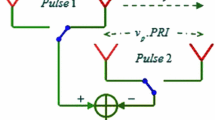Abstract
A joint-pixel clutter suppression method based on slope compensation is proposed in this paper. In order to eliminate the effect of the terrain interferometric phase caused by the cross-track baseline in hybrid baseline InSAR, the local independent identical distribution of the clutter is satisfied by using the slope compensation technique, and thus the clutter can be suppressed successfully by using the orthogonality of the clutter subspace and the noise subspace. This approach utilizes the information contained in the current pixel as well as in its neighbors, showing robustness to the image coregistration errors. Both the simulated data and the real airborne data are used in proving the validity of the presented approach.
Similar content being viewed by others
References
Rosen P A, Hensley S, Joughin I R, et al. Synthetic aperture radar interferometry. Proc IEEE, 2000, 88(3): 333–381
Li Z, Bao Z, Yang F. Ground moving target detection and location based on SAR images for distributed spaceborne SAR. Sci China Ser F-Inf Sci, 2005, 48(5): 632–646
Massonnet D. Capabilities and limitations of the interferometric Cartwheel. IEEE Trans Geosci Remote Sens, 2001, 39(3): 506–520
Romeiser R, Current Measurements by airborne along-track InSAR: measuring technique and experimental results. IEEE J Ocean Engin, 2005, 30(3): 552–569
Chapin E, Chen C W. GMTI along-track interferometry experiment. IEEE AE Syst Mag, 2006, 21(3): 15–20
Sansosti E, Berardino P, Manunta M, et al. Geometrical SAR image registration. IEEE Trans Geosci Remote Sens, 2006, 44(10): 2861–2870
Yu Q, Fu S, Mayer H, et al. Coregistration based on three parts of two complex images and contoured windows for synthetic aperture radar interferometry. IEEE Geosci Remote Sens Lett, 2007, 4(2): 288–292
Sikaneta I, Gierull C, Chouinard J Y. Metrics for SAR-GMTI based on eigen-decomposition of the sample covariance matrix. In: Proceedings of the International Radar conference 2003. Washington: IEEE Press. 442–447
Lipps R, Chen V, Bottoms M. Advanced SAR GMTI techniques. In: Proceedings of the International Radar Conference 2004. Washington: IEEE Press: 105–110
Li Z, Bao Z, Li H, et al. Image auto-coregistration and In-SAR interferogram estimation using joint subspace projection. IEEE Trans Geosci Remote Sens, 2006, 44(3): 288–297
Xu W, Cumming I. A region-growing algorithm for InSAR phase unwrapping. IEEE Trans Geosci Remote Sens, 1999, 37(1): 124–134
Author information
Authors and Affiliations
Corresponding author
Additional information
Supported in part by the National Nature Science Foundation of China (Grant No. 60802074) and the Program for New Century Excellent Talents in University
Rights and permissions
About this article
Cite this article
Suo, Z., Li, Z., Bao, Z. et al. SAR-GMTI investigation in hybrid along- and cross-track baseline InSAR. Sci. China Ser. F-Inf. Sci. 52, 1399–1408 (2009). https://doi.org/10.1007/s11432-009-0102-0
Received:
Accepted:
Published:
Issue Date:
DOI: https://doi.org/10.1007/s11432-009-0102-0




